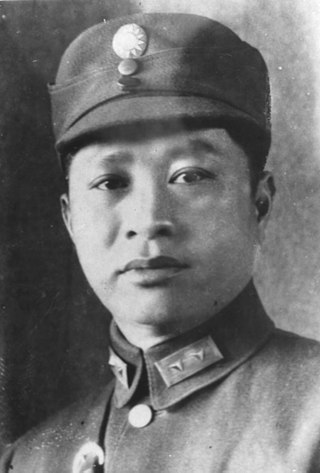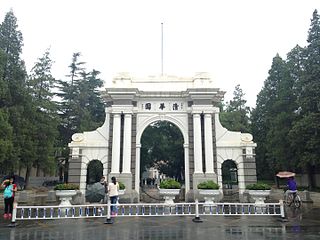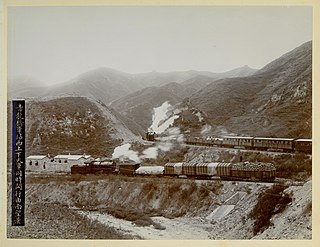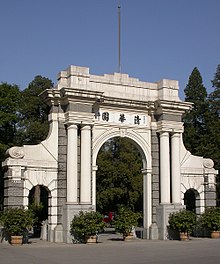
Tsinghua University (THU) is a public university in Haidian, Beijing, China. It is affiliated with and funded by the Ministry of Education of China. The university is part of Project 211, Project 985, and the Double First-Class Construction. It is also a member in the C9 League.

The National Emblem of the People's Republic of China is a national symbol of the People's Republic of China and contains in a red circle a representation of Tiananmen Gate, the entrance gate to the Forbidden City, where Mao Zedong declared the foundation of the People's Republic of China (PRC) in 1949. Above this representation are the five stars found on the national flag. The largest star represents the Chinese Communist Party (CCP), while the four smaller stars represent the four revolutionary social classes as defined in Maoism. The emblem is described as being "composed of patterns of the national flag":
...The red color of the flag symbolizes revolution and the yellow color of the stars the golden brilliant rays radiating from the vast red land. The design of four smaller stars surrounding a bigger one signifies the unity of the Chinese people under the leadership of the Communist Party of China (CPC).
—China Yearbook 2004

The Great Hall of the People is a state building situated to the west of Tiananmen Square in Beijing. It is used for legislative and ceremonial activities by the government of the People's Republic of China. The People's Great Hall functions as the meeting place for the full sessions of China's legislature, the National People's Congress, which occurs every year during March along with the national session of the Chinese People's Political Consultative Conference, a political advisory body. The Great Hall is also the meeting place of the National Congress of the Chinese Communist Party, which, since the 12th conference in 1982, has occurred once every five years, and the party's Central Committee which meets approximately once a year.
White Horse Temple is a Buddhist temple in Luoyang, Henan that, according to tradition, is the first Buddhist temple in China, having been first established in 68 AD under the patronage of Emperor Ming in the Eastern Han dynasty.

Haidian is an urban district of the city of Beijing, China, mostly in northwestern Beijing, bordering Xicheng and Fengtai.

Kunming Lake is the central lake on the grounds of the Summer Palace in Haidian District, Beijing, China. Together with the Longevity Hill, Kunming Lake forms the key landscape features of the Summer Palace gardens.

Ye Ting was a Chinese military officer and figure who played a key role in the Northern Expedition to reunify China after the 1911 Revolution. After serving with the Kuomintang, Ye later joined the Chinese Communist Party (CCP).

The Chairman Mao Memorial Hall, also known as the Mausoleum of Mao Zedong, is the final resting place of Mao Zedong, Chairman of the Politburo of the Chinese Communist Party from 1943 and the Chairman of the Chinese Communist Party from 1945 until his death in 1976.

Qinghuayuan railway station was a railway station in Beijing.

Line 7 of the Beijing Subway is a rapid transit line in Beijing. It runs parallel and to the south of Line 1 and Batong line, from the Beijing West railway station in Fengtai District to Universal Resort in Tongzhou District. Like Line 6, Line 7 provides additional relief to the overcapacity Line 1 adding another east–west trunk line to the Beijing Subway network. The line uses 8-car Type B trains. Line 7's color is light orange.
The Tsinghua Bamboo Strips are a collection of Chinese texts dating to the Warring States period and written in ink on strips of bamboo, that were acquired in 2008 by Tsinghua University, China. The texts were obtained by illegal excavation, probably of a tomb in the area of Hubei or Hunan province, and were then acquired and donated to the university by an alumnus. The very large size of the collection and the significance of the texts for scholarship make it one of the most important discoveries of early Chinese texts to date.

Fu Yue, also known as Hou Que, was an official who served as minister from Fuyan under the king Wu Ding 武丁 of the Shang 商 dynasty, who reigned around c. 1250–c. 1200 BCE. He has also been defined anachronistically a "premier."

Qinghuayuan Subdistrict is a subdistrict of Haidian District, Beijing, It shares border with Dongsheng Town in the northeast, Xueyuan Road Subdistrict in the east, Yanyuan and Zhongguancun Subdistricts in the south, and Qinglongqiao Subdistrict in the northwest. As of 2020, it had a population of 56,592 under its administration.

Founded in 1911, the Tsinghua University is located on the site of Tsinghua Garden in Beijing, the former residence of Prince Yinzhi, the third son of the Kangxi Emperor of the Qing dynasty.

Jingming Garden is an imperial garden on the Jade Spring Hill in Beijing, China, west of the Summer Palace. It is one of Major Historical and Cultural Site Protected at the National Level.

Tsinghua Garden is an extensive garden in Haidian District, Beijing, China. Constructed during the reign of the Kangxi Emperor in the Qing dynasty, it was originally named "Xichun Garden". Later, it was divided into two gardens: Chunze Garden and Hande Garden. Chunze Garden and Hande Garden were later respectively renamed to "Jinchun Garden" and "Xichun Garden". In 1852, during the reign of the Xianfeng Emperor, the garden was renamed again to "Qinghua Garden". In the present-day, "Tsinghua Garden" generally refers to the locations of the Tsinghua University, such as Tsinghua Garden, Jinchun Garden, and other Qing dynasty gardens in the university.

Brown Stone is an affluent neighborhood in Haidian District, Beijing, China, surrounded by the famous Tsinghua University and the Old Summer Palace. Originally developed by the Beijing Taiyue Real Estate Development Company (北京泰跃房地产开发有限责任公司) in 2005, it now run by its affiliated estate keeping company. The neighborhood was developed in two stages, with the first stage finished in 2008, while the second stage was not completed until 2010.

The Beijing–Zhangjiakou Railway or Jingzhang Railway, also known as the Imperial Peking–Kalgan Railway, is China’s first railway that has been designed and built solely by Chinese, situated in the nation’s capital Beijing and Zhangjiakou City in Hebei Province. It was built in 1905–1909 under the proposal of Viceroy of Zhili Yuan Shikai and Assistant Director-General of Railways Hu Yufen (胡燏棻), with Zhan Tianyou as engineer-in-chief. When building the railway, Zhan reduced the length of Badaling Tunnel by using a switchback—or “人”-shaped rail track called in China as the shape of it resembles the Chinese character “人” ; he also used vertical shafts to facilitate the excavation of the tunnel.
National Tsing Hua University Scientific Research Industrialization Platform of Five Universities Alliance is a platform for industrialization of scientific research supported by the Ministry of Science and Technology of Taiwan (MOST), with the National Tsing Hua University (NTHU) in Hsinchu as the head, and the integration of five universities.

Zhang Dayu was a Chinese chemist who specialised in physical chemistry. He was a founding member of the Chinese Academy of Sciences.

















